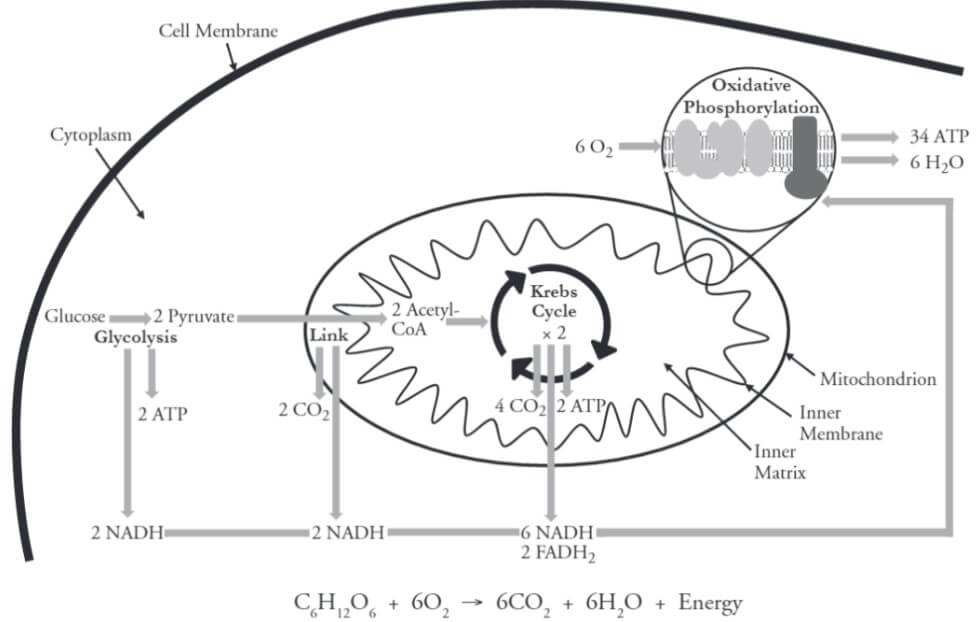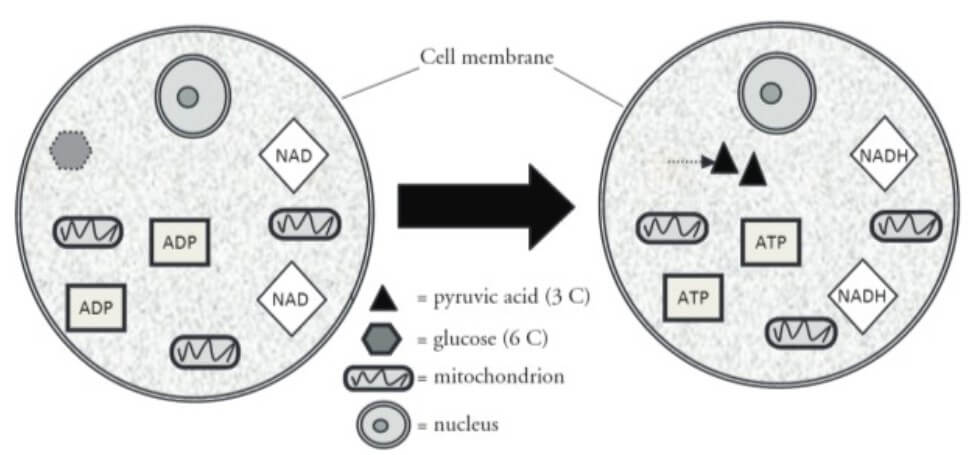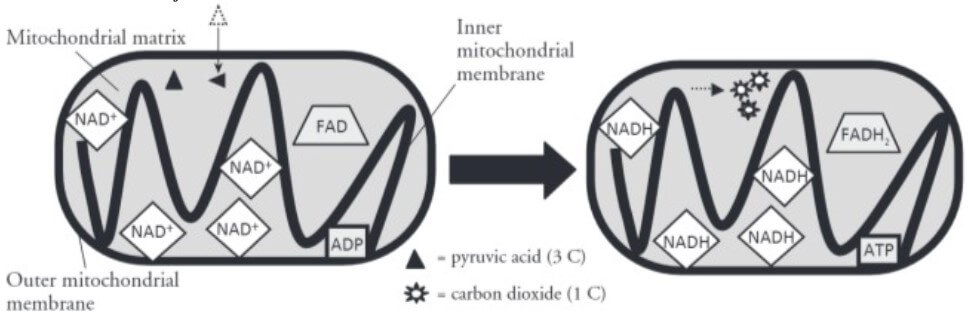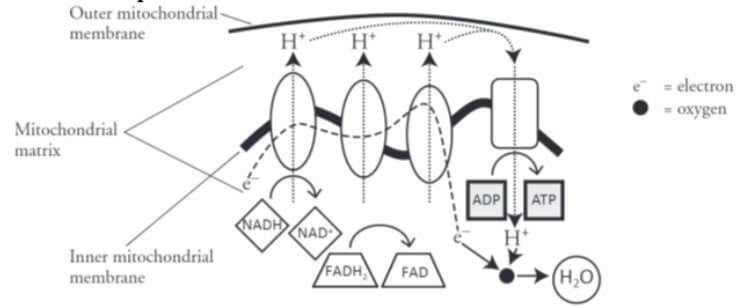Interested in knowing FREE answers key for Cellular Respiration Pogil questions?
If YES, check below for the right answers…
Free Pogil Cellular Respiration Model Questions & Answers
Below we just brought you Pogil cellular respiration model 1, model 2, model 3, model 4 & model 5 questions all together with answers.
NOTE: All answers are checked twice before publishing them to you. So, please share if it helps you.

Model 1: Cellular Respiration

Q. According to Model 1, what are the reactants of cellular respiration?
Ans: Glucose and Oxygen
Q. According to Model 1, what are the products of cellular respiration?
Ans: Carbon Dioxide, Water, and ATP
Q. Cellular respiration occurs in four phases: glycolysis, the link reaction, the Krebs cycle, and oxidative phosphorylation.
a. Which phase of cellular respiration occurs in the cytoplasm of the cell?… Ans: Glycolysis
b. Which phases of cellular respiration occur in the mitochondria?… Ans: Link reaction and Krebs cycle, Oxidative phosphorylation
c. Which of the four phases of cellular respiration require oxygen?… Ans: Oxidative phosphorylation
d. Which of the four phases of cellular respiration produces carbon dioxide?… Ans: the link reaction, the Krebs cycle
e. Which of the four phases of cellular respiration produces water?… Ans: oxidative phosphorylation.
Q. The goal of cellular respiration is to provide the cell with energy in the form of ATP.
a. Which of the four phases of cellular respiration result in the production of ATP?… Ans: the link reaction, the Krebs cycle, oxidative phosphorylation
b. How many ATPs (total) are produced for every glucose molecule that undergoes cellular
respiration?… Ans: 38
c. What reactants of ATP must be available in the cell in order to produce ATP?… Ans: ADP and P available
d. Brainstorm several cellular processes for which energy or ATP is necessary. List at least four
here:… Ans: movement, muscle contraction, biochemical reaction, and metabolism
Q. Consider Model 1. Besides ATP, what other molecules appear to be high potential energy molecules (free energy carriers) during cellular respiration?
Ans: NADH, FADH
Model 2: Glycolysis

Q. Refer to Model 2.
a. What is represented by the hexagon?… Ans: Glucose
b. How many carbon atoms (C) are in one molecule of glucose?… Ans: 6
Q. Refer to Model 2.
a. What is represented by the triangles?… Ans: Pyruvic Acid
b. How many carbon atoms (C) are in one molecule of pyruvic acid?… Ans: 3
Q. In the process of glycolysis, what happens to glucose after it crosses the cell membrane into the cytoplasm of the cell?
Ans: It turned into Pyruvic Acid, two of them which equal 6 carbon between them
Q. Glycolysis occurs in the cytoplasm of cells and does not require the presence of oxygen. Therefore, the process is anaerobic. It is the first step used by cells to extract energy from glucose in the form of ATP. ATP can be directly used by cells. Thinking about the number of carbon atoms in glucose and in pyruvic acid, explain why there is one molecule of glucose on the left side of the arrow and two molecules of pyruvic acid on the right side of the arrow.
Ans: Because of how reactions work, you can’t get rid of molecules, so 6 went in 6 came out, the weight isn’t different.
Q. How many ATP molecules are produced during glycolysis?
Ans: 2
Q. Hydrogen-carrying molecules are also produced during glycolysis. What is the symbol of these
hydrogen-carrying molecules?
Ans: NAD
Q. Does glycolysis occur inside or outside the mitochondria?
Ans: Yes. Glycolysis happens outside of the mitochondria.
Model 3: Krebs Cycle

Q. According to Model 3, what happens to pyruvic acid during the Krebs cycle?
Ans: It is turned into carbon dioxide
Q. According to Model 3, where does the change identified in #13 above occur?
Ans: Osmosis
Q. Note the number of atoms of carbon in pyruvic acid and explain why three molecules of carbon dioxide are produced.
Ans: Three for every acid given, and carbon only need one, so there are three.
Q. Considering that glycolysis produces two pyruvic acid molecules per glucose molecule, how many
total CO2 molecules will be produced from the complete breakdown of each glucose molecule? Show a mathematical equation to support your answer.
Ans: 3+3=6 & 6/1=6
Q. What two hydrogen-carrying molecules are formed during the Krebs cycle?
Ans: NADH, FADH
Q. Fill out the chart by looking back at the entire process of glycolysis and the Krebs cycle to list the total number of ATPs and hydrogen-carrying molecules produced.
Ans:…check below table…
| Process | ATP | NADH | FADH |
| Glycolysis | 2 | 2 | 0 |
| Krebs Cycle 1st pyruvic acid | 1 | 4 | 1 |
| Krebs Cycle 2nd pyruvic acid | 1 | 4 | 1 |
Model 4: The Electron Transport Chain

Q. What cell structure is the site for the electron transport chain?
Ans: The inner mitochondrial membrane/cristae
Q. Label the carrier proteins in Model 4.
Ans: H+
Q. What substance do the carrier proteins transport across the inner mitochondrial membrane?
Ans: Hydrogen ions (h+)
Q. NADH and FADH2 molecules release hydrogen ions that are transported across the inner
mitochondrial membrane with the help of electrons. The result of these multiple processes is the
production of large amounts of ATP. What high-energy molecules are formed by the electron transport chain?
Ans: In the process, protons are pumped from the mitochondrial matrix to intermembrane space, & O2 is reduced to form H2O.
Q. Refer to Model 4
a. What atom accepts the H+ ion at the end of the electron transport chain?… Ans: Oxygen accepts the hydrogen ions
b. What molecule is formed as a product of that acceptance?… Ans: Water, h2o, is formed as a product.
Q. Formulate an explanation for why the events of the electron transport chain constitute an aerobic process rather than an anaerobic process (like glycolysis).
Ans: The electron transport chain is an aerobic process because it requires oxygen to complete the process.
Q. Remember that glycolysis produces two pyruvic acid molecules per glucose molecule along with two of the hydrogen-carrying NADH molecules. Remember also that the Krebs cycle produces NADH as well as another hydrogen carrier called FADH2. It is important to know that during the electron
transport chain, when each NADH gives up electrons and hydrogen ions, there is enough
potential energy change to make three ATP molecules. When each FADH2 gives up electrons and
hydrogen ions, there is enough potential energy change to make two ATP molecules.
Fill in the chart below to calculate the total amount of ATP produced from the breakdown of each
glucose molecule during the three steps of cellular respiration.
Ans: …check below table…
| # of ATP produced from 1 glucose | NADH (# of H-carriers produced from 1 glucose) | FADH (# of H-carriers produced from 1 glucose) | |
| Glycolysis | 2 | 2 | 0 |
| Krebs Cycle | 2 | 8 | 2 |
| Electron Transport Chain | ——— | x3 | x2 |
| Total ATP produced | 4 | 30 | 4 |
| Grand total of ATP produced (add all 3 columns) | Total-> 4+30+4=38 |
Q. Look at the equation for cellular respiration and write in which stage of the process each molecule is either used or produced.
Ans:

Used in:
Glycolysis (1st)
Electron Transport Chain (2nd)
Produced in:
Kreb’s cycle (3rd)
Electron Transport Chain (4th)
Glycolysis – 2 {
Kreb’s – 2 { (5TH)
E.T.C. – 34 {
Q. Compare the ATP available to cells when oxygen is present versus when it is absent. How might this help explain why brain and heart functions are so quickly affected when a person cannot breathe?
Ans: Since there would be so little ATP produced without oxygen, the Cells of the brain and heart would die and the functions would stop.
Model 5: Energy in Anaerobic Environments

Q. Examine the two anaerobic processes in Model 5. Is oxygen used in either process?
Ans: No
Q. What is the definition of anaerobic?
Ans: Without Oxygen
Q. Compare the energy output (in the form of ATP) for a single glucose molecule that undergoes
glycolysis and fermentation to that of a glucose molecule undergoing cellular respiration.
Ans: Make fewer ATP against glucose molecule
Q. What common foods involve the process of fermentation? Use your textbook or another resource to make a list of at least five foods and the specific organism used.
Ans:
Cheese- various fungi
Bread- Saccharomyces cerevisiae & other yeasts
Yogurt- various bacteria
Sauerkraut – various bacteria.
Vinegar – various bacteria.
Q. The muscle “burn” that you feel when doing a strenuous activity (sprints for example) is caused by a buildup of lactic acid in the muscle tissue of your body. Explain this phenomenon in the context of cellular respiration and fermentation.
Ans: When muscles require more energy aerobically, they switch to anaerobic respiration, the lactic acid produced builds up & produces a burning sensation in the muscles.
Q. The evolution of photosynthesizing organisms on Earth and the development of an oxygen-rich
the environment led to a rapid diversification of life. Explain why there is an evolutionary advantage to an organism that requires oxygen to live compared to one that does not require oxygen.
Ans: An organism that can metabolize glucose in an oxygen-rich environment can make far more ATP per glucose molecule than an organism that uses anaerobic processes.
>> Other Pogil Answer Key <<
About Cellular Respiration
Cellular respiration is a process in which cells use nutrients to produce energy. It is the main way that organisms are able to get energy from their environment.
There are two ways of looking at cellular respiration, as glycolysis and the citric acid cycle. The first step is glycolysis, where glucose has its molecules taken apart to release energy.
The citric acid cycle takes the byproducts of glycolysis and uses them to set off more chemical reactions that result in even more ATP production.
This is the final stage that releases the majority of energy produced through cellular respiration. This process releases a lot of energy into ADP, which is then turned into ATP by adding phosphate.
Cellular respiration is essential to every living organism because it is the only way that they can get energy from their surroundings in order to survive and grow.
Humans perform cellular respiration in the cells of our bodies in order to gain energy that we need to move, grow, think, etc.
Further Reference: https://www.britannica.com/science/cellular-respiration
That’s all. Hope you find the Pogil Cellular Respiration Answer Key with a detailed summary by following our answers above.
Share with your batchmates if you find it helpful.

Hi, I’m Thomas, and I’ve been a teacher for over 10 years and have taught students at all levels. I created this blog to really help students get ahead of their exams as well as provide helpful guides on various courses.
